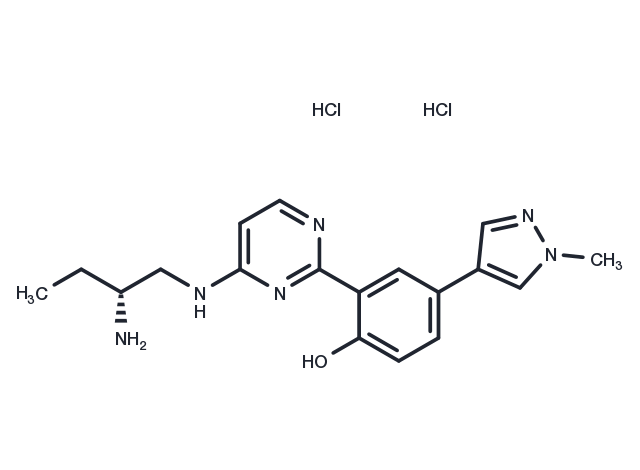Powder: -20°C for 3 years | In solvent: -80°C for 1 year


CRT0066101 dihydrochloride is an effective and selective PKD inhibitor (IC50s: 1, 2.5 and 2 nM for PKD1, 2, and 3).

| Pack Size | Availability | Price/USD | Quantity |
|---|---|---|---|
| 1 mg | In stock | $ 31.00 | |
| 5 mg | In stock | $ 72.00 | |
| 10 mg | In stock | $ 122.00 | |
| 25 mg | In stock | $ 247.00 | |
| 50 mg | In stock | $ 393.00 | |
| 1 mL * 10 mM (in DMSO) | In stock | $ 79.00 |


| Description | CRT0066101 dihydrochloride is an effective and selective PKD inhibitor (IC50s: 1, 2.5 and 2 nM for PKD1, 2, and 3). |
| Targets&IC50 | PKD1:1 nM, PKD2:2.5 nM, PKD3:2 nM |
| In vitro | CRT0066101 specifically blocks PKD1/2 activity and does not suppress PKCα/PKCβ/PKCε activity in multiple cancer cell types including A549 and MiaPaCa-2. CRT0066101 significantly inhibits Panc-1 cell proliferation (IC50: 1 μM). Treatment with CRT0066101 results in a 6-10 fold induction of apoptosis in Panc-1 cells. CRT0066101 significantly reduces cell proliferation of Panc-1, Colo357, MiaPaCa-2, and AsPC-1 cells but has a modest effect in Capan-2 cells. CRT0066101 (5 μM) blocks both the basal and NT-induced pS916-PKD1/2 (activated PKD1/2) in Panc-1 and Panc-28 cells. CRT0066101 reduces PKD-dependent NF-κB activation and NF-κB-dependent gene expressions in Panc-1. |
| In vivo | Optimal therapeutic concentrations of CRT0066101 (8 μM) are achieved 6 h post-oral administration. A 28-day oral regimen of CRT0066101 (80 mg/kg/day) markedly reduces Panc-1 subcutaneous xenograft growth, with a significant inhibition of activated PKD1/2 expression observed. The peak tumor concentration of CRT0066101 (12 μM) is reached within 2 h, indicating rapid absorption. Additionally, administering CRT0066101 orally (80 mg/kg/day) for 21 days in a Panc-1 orthotopic model effectively inhibits tumor growth in vivo. This intervention significantly decreases the Ki-67+ proliferation index, increases TUNEL+ apoptotic cell counts, and suppresses the expression of NF-κB-dependent proteins, including cyclin D1, survivin, and cIAP-1. |
| Animal Research | Nineteen days after implantation of Panc-1 cells, tumor areas are, on average 0.3 cm2 and are randomized into the following groups (n=8 mice per group): (a) vehicle (control) 5% dextrose administered by oral gavage once daily and (b) 80 mg/kg CRT0066101 dissolved in 5% dextrose administered by oral gavage once daily. Tumors are measured in 2 dimensions every 2 to 3 days by calipers and area is calculated by multiplying the length by width. Therapy is given until tumors reached their designated size limits (1.44 cm2) or until day 24 in CRT0066101 treated group. Final tumor areas are compared among groups using a Student's t-test and Fisher's exact test. |
| Molecular Weight | 411.33 |
| Formula | C18H22N6O.2HCl |
| CAS No. | 1883545-60-5 |
Powder: -20°C for 3 years | In solvent: -80°C for 1 year
DMSO: 23 mg/mL (55.92 mM)
You can also refer to dose conversion for different animals. More
bottom
Please see Inhibitor Handling Instructions for more frequently ask questions. Topics include: how to prepare stock solutions, how to store products, and cautions on cell-based assays & animal experiments, etc.
CRT0066101 dihydrochloride 1883545-60-5 Cell Cycle/Checkpoint Metabolism Serine/threonin kinase Inhibitor CRT0066101 Dihydrochloride CRT-0066101 dihydrochloride CRT 0066101 CRT0066101 CRT-0066101 Dihydrochloride Protein kinase D CRT 0066101 Dihydrochloride PKD inhibit CRT-0066101 inhibitor
